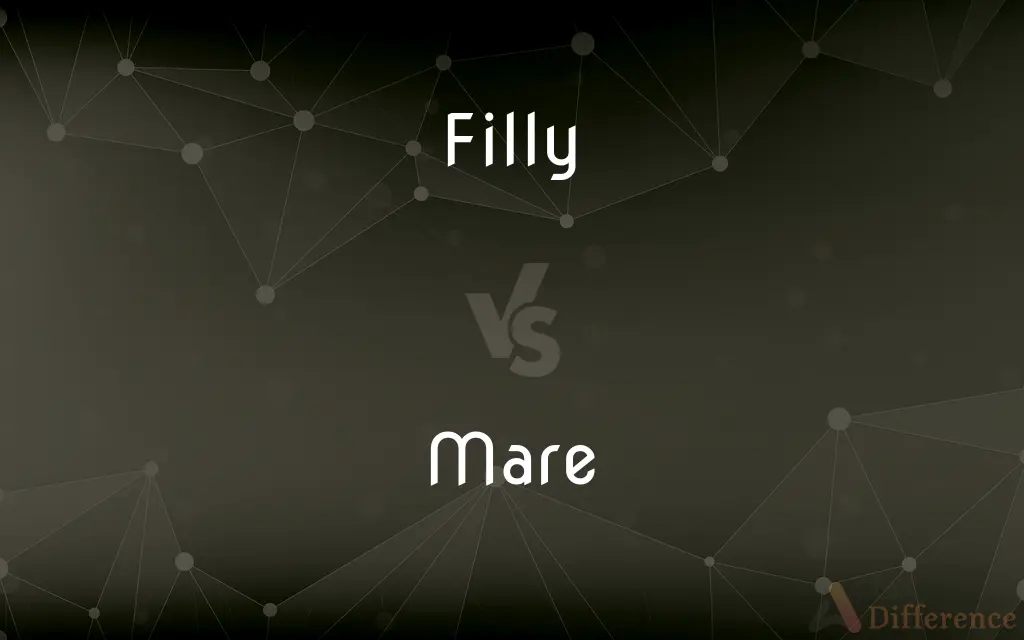Filly vs. Mare — What's the Difference?
By Tayyaba Rehman — Updated on October 28, 2023
A filly is a young female horse, usually under the age of four, while a mare is an adult female horse, typically over four years old.

Difference Between Filly and Mare
Table of Contents
ADVERTISEMENT
Key Differences
Filly and mare both refer to female horses, but their primary distinction lies in the age of the horse. A filly is, in essence, a young female horse. They are the counterparts to colts, which are young male horses. The term "filly" usually applies to female horses that are under four years of age. This designation helps horse enthusiasts and professionals quickly identify the age and gender of a young horse.
Mare, on the other hand, is a term that describes an adult female horse, typically over the age of four. When a filly grows older and reaches maturity, she transitions from being called a filly to a mare. This change in terminology indicates that the horse is no longer in her juvenile phase and is now mature, potentially ready for breeding or other adult roles.
The stages of a horse's life are often marked by distinct terms, and filly and mare play a crucial role in this. When considering horse racing, for instance, races might be organized specifically for fillies due to the differences in maturity and strength between young female and male horses. In contrast, mares might participate in different events or categories altogether.
In breeding contexts, understanding the difference between a filly and a mare is vital. A mare is generally bred to produce offspring, while a filly, due to her young age, is usually not used for breeding until she reaches the mare stage. The health, lineage, and characteristics of both fillies and mares are studied in-depth by breeders to ensure the best possible offspring.
In sum, while both filly and mare refer to female horses, their age distinction is crucial in various equestrian contexts, from racing and riding to breeding and beyond.
ADVERTISEMENT
Comparison Chart
Age
Typically under four years old
Over four years old
Maturity
Young and not yet fully mature
Fully matured
Breeding
Generally not used for breeding
Often used for breeding
Racing and Competitions
Often have races specifically for fillies
Participate in different events or categories
Terminology Transition Point
Becomes a "mare" after reaching a certain age
Was a "filly" before reaching maturity
Compare with Definitions
Filly
The female counterpart to a colt.
While the colt was robust and boisterous, the filly was graceful.
Mare
Typically over four years of age.
The five-year-old mare has won many competitions.
Filly
Generally under the age of four.
That filly is only two years old and already shows great potential.
Mare
Has transitioned from the filly stage.
Once a spirited filly, she's now a calm and wise mare.
Filly
Participates in specific races for young female horses.
The filly won her first race, showcasing her speed and agility.
Mare
Participates in adult horse events and categories.
The mare was a favorite in the upcoming equestrian event.
Filly
Not yet mature enough for breeding.
They decided to wait a few years before breeding the filly.
Mare
A mare is an adult female horse or other equine.In most cases, a mare is a female horse over the age of three, and a filly is a female horse three and younger. In Thoroughbred horse racing, a mare is defined as a female horse more than four years old.
Filly
A filly is a female horse that is too young to be called a mare. There are two specific definitions in use: In most cases, a filly is a female horse under four years old.
Mare
An adult female horse or the adult female of other equine species.
Filly
A young female horse, especially one less than four years old.
Mare
An adult female horse.
Filly
A young female horse, especially a racehorse less than five years old, or a young female of another equine species.
Mare
A foolish woman.
Filly
(Informal) A lively, high-spirited girl or young woman.
Mare
A type of evil spirit formerly thought to sit on the chest of a sleeping person; also, the feeling of suffocation felt during sleep, attributed to such a spirit.
Filly
A young female horse.
Mare
A nightmare; a frustrating or terrible experience.
I'm having a complete mare today.
Filly
(dated) A young, attractive woman.
Hey, Homer, get a load of the gams on that filly!
Mare
(planetology) A large, dark plain, which may have the appearance of a sea.
Filly
A female foal or colt; a young mare. Cf. Colt, Foal.
Neighing in likeness of a filly foal.
Mare
(planetology) On Saturn's moon Titan, any of several lakes which are large expanses of what is thought to be liquid hydrocarbons.
Kraken Mare (a lake of liquid hydrocarbons on Titan which is slightly larger than the Caspian Sea)
Filly
A lively, spirited young girl.
Mare
Obsolete form of mayor
Filly
A young female horse under the age of four
Mare
Obsolete form of mair
Mare
The female of the horse and other equine quadrupeds.
Mare
Sighing, suffocative panting, intercepted utterance, with a sense of pressure across the chest, occurring during sleep; the incubus; - obsolete, except in the compound nightmare.
I will ride thee o' nights like the mare.
Mare
Female equine animal
Mare
A dark region of considerable extent on the surface of the moon
Mare
Suitable for breeding.
The breeder selected the mare for her excellent lineage.
Common Curiosities
Are there specific races for fillies?
Yes, there are often races specifically designed for fillies due to their age and strength differences.
At what age does a filly become a mare?
A filly usually becomes a mare at around four years of age.
Can a filly be used for breeding?
Typically, fillies are not used for breeding until they mature into mares.
How does one differentiate between a filly and a mare visually?
Age and physical maturity are key indicators, but for precise differentiation, knowing the horse's age is crucial.
Are mares more temperamental than fillies?
Temperament can vary among individual horses regardless of age, but mares can have hormonal cycles that influence behavior.
How long does a mare's reproductive cycle last?
A mare's estrous cycle is about 21 days, but this can vary.
Do mares have better temperaments after giving birth?
It varies. Some mares become calmer, while others may be more protective or aggressive.
Can a mare return to racing after giving birth?
Yes, with proper care and training, mares can return to racing postpartum.
Is "colt" the male counterpart to "filly"?
Yes, a colt is a young male horse, just as a filly is a young female.
Is there a specific term for a female horse used only for breeding?
While "broodmare" refers to mares used primarily for breeding, any mare can potentially breed.
What is the primary difference between a filly and a mare?
A filly is a young female horse under four years, while a mare is an adult female horse over four.
Do mares and male adult horses have the same strength?
Mares and adult male horses (stallions or geldings) can vary in strength based on individual genetics, training, and care.
Can both fillies and mares participate in equestrian sports?
Yes, both can participate, but events might be categorized based on age and maturity.
Why are some races exclusive to fillies?
Exclusive races ensure fair competition among young horses of similar age and development.
How long is the gestation period for mares?
The average gestation period for mares is about 11-12 months.
Share Your Discovery

Previous Comparison
Ava vs. Aba
Next Comparison
Hometown vs. AddressAuthor Spotlight
Written by
Tayyaba RehmanTayyaba Rehman is a distinguished writer, currently serving as a primary contributor to askdifference.com. As a researcher in semantics and etymology, Tayyaba's passion for the complexity of languages and their distinctions has found a perfect home on the platform. Tayyaba delves into the intricacies of language, distinguishing between commonly confused words and phrases, thereby providing clarity for readers worldwide.
















































